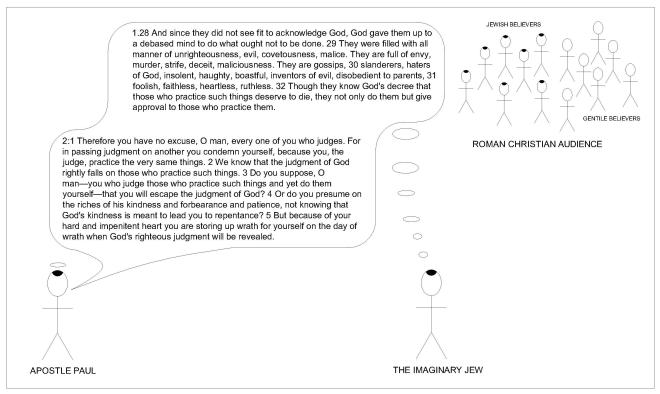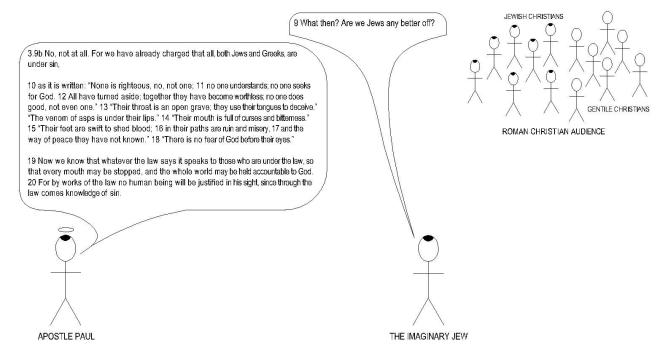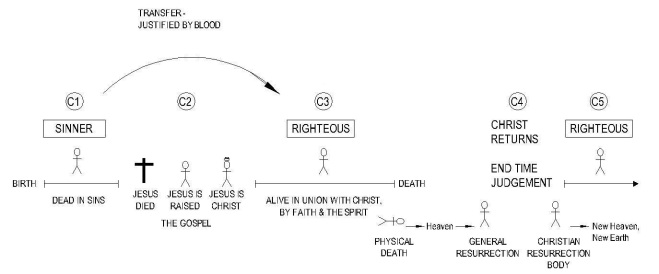 Romans is the longest and most complicated of Paul’s letters. The introduction is longer than normal. Refer to my page describing the New Perspective on Paul for some explanations of the terms ‘Law’, ‘Works of Law’, ‘Gospel’ and ‘Justification’.
Romans is the longest and most complicated of Paul’s letters. The introduction is longer than normal. Refer to my page describing the New Perspective on Paul for some explanations of the terms ‘Law’, ‘Works of Law’, ‘Gospel’ and ‘Justification’.
As I have demonstrated in this series, the Romans 1.18-4.22 contains a rhetorical device called speech in character. Paul is not speaking directly to the Roman believers. He is speaking to an imaginary Jew.
 Here is a summary of the key points in the series:
Here is a summary of the key points in the series:
- D1) Paul spoke the text aloud in front of his scribe Tertius who wrote it down (Rom 16.22; 11.13).
- D2) The Roman audience had the text read out aloud in front of them.
- D3) The Roman audience consisted of predominately Gentile believers with some Jewish believers or God-fearing Gentiles.
- D4) An unassisted forward reading of the Romans 1-4 is contradictory and confusing because –
- D5) In the letter Paul is speaking to an imaginary Jew (IJ) in front of the Roman believers (Rom 2.17, cf 2.1-29).
- D6) The interaction between Paul and IJ dominates most of Romans 1-4
- a) Paul and IJ speak to one another (cf. Rom 3.1-9; 3.27-4.1).
- b) Paul is responding to IJ who has judged Greeks (cf. 2.1-5; 1.18-32; 3.9b).
See my series Dialogue for my working out and the final post for a sneak peek of the scripted text.
I’ve created the table below to show the movement from Rom 1.18-32 to Rom 4.23-25 and various aspects of the text.

Here is a quick run down of the four chapters.
The dialogue starts off with a condemnation on the unrighteousness of Greeks (Rom 1.18-32). The Greek believers in the Roman church may have experienced this kind of condemnation since Paul’s statements are very similar to those in the Wisdom of Solomon.

This condemnation Paul attributes to IJ the ‘Judge’ (Rom 2.1-5,17). IJ judges the Greeks and Paul takes issue with this.

Paul tells IJ the Jews are no better than those he judges and puts them under God’s judgment as well (Rom 2.17-3.20).

While Paul is doing this he alludes to obedient Gentiles in opposition to IJ’s earlier judgment (Rom 2.6-11, 14, 25-29). These statements would have affirmed the Gentile believers in the Roman audience.
The climax of the first section is the Jews are sinners too. Even though they observe they works of law – in the end judgment, this way of identifying the Jews as the righteous will not be the way God identifies the righteous (Rom 3.19-20). The story of the Jews (the law) has shown them to be under sin all along.
 Paul then introduces the faithfulness of Christ and faith in Christ (Rom 3.21-26). Firstly in conjunction with the first kind of justification I’ve described in the New Perspective page. Sinners become righteous through the redemption that is in Christ Jesus (Rom 3.24).
Paul then introduces the faithfulness of Christ and faith in Christ (Rom 3.21-26). Firstly in conjunction with the first kind of justification I’ve described in the New Perspective page. Sinners become righteous through the redemption that is in Christ Jesus (Rom 3.24).
This of course has happened already to the Roman Christians when they first heard the gospel. We know from the start of the letter they are believers (Rom 1.8). Therefore they have already been made righteous by the faithfulness of Christ (cf. Rom 5.1,9), God’s sin offering which atoned for their sin on the cross.
 Once begun, this ongoing faith (or faithfulness) enables them to receive the benefits of Christ’s atoning death which satisfies God’s just judgment on sin.
Once begun, this ongoing faith (or faithfulness) enables them to receive the benefits of Christ’s atoning death which satisfies God’s just judgment on sin.
Then he describes the second kind of justification in relation to those who have faith in Jesus (Rom 3.26). Again this includes the Roman believers listening to the letter being read out to them.
 God tells who the righteous are by their faith in Christ (Rom 3.26).
God tells who the righteous are by their faith in Christ (Rom 3.26).
Very simply – the righteous are those who believe Jesus is the Christ.
Paul tells IJ, those who believe Jesus is the Christ include both Jews and Gentiles (Rom 3.27-31). At this point the Roman believers (Jews and Gentiles) should realise they are believers like the ones Paul is speaking about because they believe Jesus is the Christ. In particular Paul makes it clear to IJ this includes Gentile believers.

Thus Paul defends Gentile believers against IJ who condemned all Gentiles (Rom 2.1-5; 1.18-32).
Paul then shows how Abraham’s faith / faithfulness was counted as covenant righteousness while he was a Gentile (Rom 4). He does this to include believing Gentiles in the saving purposes of God.

Paul switches back to speaking to the Roman believers and ends this section with his main point in performing the dialogue. The Roman church (Rom 1.8-12), both Jews and Gentiles who believe that God raised the Lord Jesus from the dead will be (future tense) identified as the righteous by God (Rom 4.23-25).

His main point is assurance for the Roman believers and particularly the Gentiles who in the historical context were prone to be condemned by Jews like IJ.
Overall in Romans
Paul explains to all the Roman believers that their common faith in Jesus Christ is the reason why they are all righteous before God (1:16–4:25). He then spells out what the Christian life looks like in terms of both present experience and future hope (5:1–8:39). In chapters 9-11, he expresses his sorrow that many of his fellow Israelites have not recognised Jesus is the Christ, and explains the implications of this for the Gentile believers. In the last few chapters he teaches how the mercies of God should affect the churches everyday life (chs. 12–16). Paul wrote his letter to Rome in about A.D. 57.
Copyright © Joshua Washington and thescripturesays, 2015. All Rights Reserved.